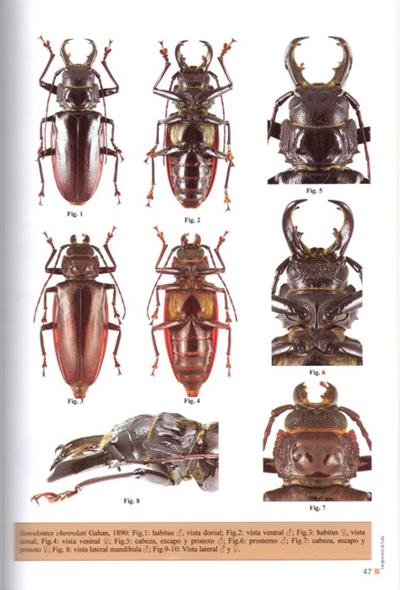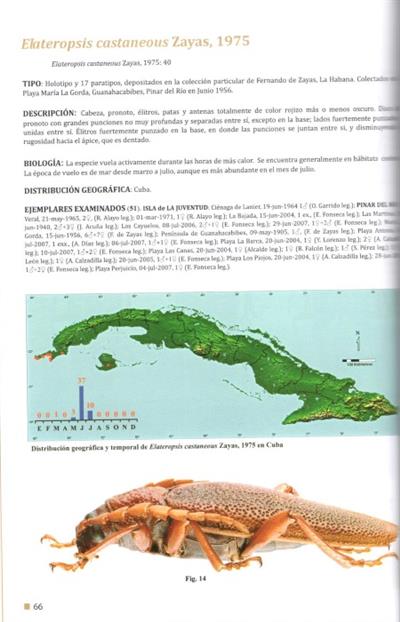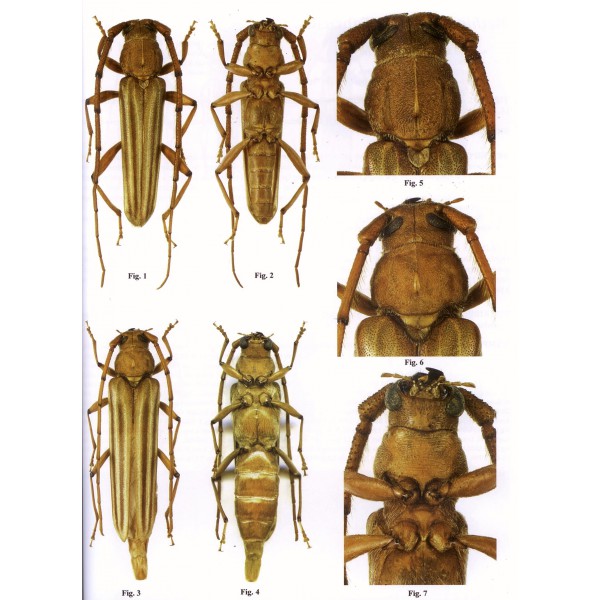| Author |
 Topic Topic  |
|
|
SDevesa
Member Purpuricenus
 
Spain
282 Posts |
 Posted - 14/01/2016 : 20:05:20 Posted - 14/01/2016 : 20:05:20



|
Dear people: Please let me introduce my new book about the Cerambycidae from Cuba.
LONGICORNIOS DE CUBA (COLEOPTERA: CERAMBYCIDAE)
Vol. 1: PARANDRINAE, PRIONINAE, SPONDYLINAE, CERAMBYCIDAE
Sergio Devesa, Elier Fonseca y Alejandro Barro
356 pages, 1.302 photos full color, paperback. 17 x 24,5 cm.
Distributor: Entomopraxis (www.entomopraxis.com)
Collecting data of almost 15,000 specimens in 593 localities of the Island of Cuba are provided. Photos of both sexes of almost all species, dorsal, ventral and lateral view, highlighting morphological details of major diagnostic interest. With determination keys, which greatly facilitates verification of the determinations. It includes 129 species, proposing systematic or distribution changes for 19 species. For each species, their taxonomic status and types, morphological description, biology, geographical distribution (map of Cuba with the localities where it is known each species) and all data of the specimens examined, with a graph showing the collecting data with its monthly distribution. It is the first of two volumes that are the result of over 15 years of exploration in the island, as well as the review of all Cuban insect collections from the early twentieth century. The second volume will deal with the Lamiinae subfamily.
https://www.researchgate.net/publication/293794426_Longicornios_de_Cuba_Coleoptera_Cerambycidae_Vol_1_Parandrinae_Prioninae_Spondyidinae_Cerambycinae
 |
|
|
Bennyboymothman
Member Rosenbergia
   
United Kingdom
1679 Posts |
 Posted - 14/01/2016 : 22:22:17 Posted - 14/01/2016 : 22:22:17





|
| What a fantastic looking book. Good luck with it. |
 |
|
|
Golofa
Member Purpuricenus
 
France
180 Posts |
 Posted - 15/01/2016 : 08:04:05 Posted - 15/01/2016 : 08:04:05




|
I did receive it for Christmas => Very good book Congratulations !
Alain |
 |
|
|
Francesco
Forum Admin
    
Luxembourg
9511 Posts |
 Posted - 26/11/2016 : 08:55:18 Posted - 26/11/2016 : 08:55:18




|
I had the honor to write the introduction of this book, which I insert here as comment:
"Located as a bridge between the peninsulas of Florida and that of Yucatan, Cuba is a crossroad of faunas of strongly different origins. From a side the Alleghenian fauna made of Arctotertiary relict taxa of Laurasian origin, and from the other one the Neotropical fauna of Gondawanan origin.
Its large size and perpendicular position are optimal for the colonisation from both neighbouring peninsulas, but the island also is the latest of a necklace that extends it from the coasts of Venezuela to the middle of the Caribbean, constituting an ideal track for the island-jumping species.
The insularity induces the evolution of endemics, whereas the variety of continental habitats consents the surviving of peculiar species.
In short, Cuba constitutes a point of crucial interest for the biogeographical understanding of the Caribbean and for any research involving whatever natural group.
In spite of this, only two monographs treat the Cerambycofauna of the island. The first one by Chevrolat dating 1863, with several Latin descriptions and no drawings, belongs to the archaeology of the Entomology, while the second one by Zayas is the only really available work. This monumental book, rich in descriptions and author’ drawings, was finished in 1963 and unfortunately published in 1975, resulting already taxonomically outdated as it was published. Moreover, the quality is often inadequate and several small species are nearly unrecognisable.
The big increment of the research on the Cerambycids in the last decades needed to urgently review this fauna, though political reasons early and conservation reasons lately prevented the scientific development occurred in the resting Antilles.
In this puzzled context, the present work finds its location.
After having conducted a deep research in all local museum collections, the authors performed several years of field research throughout the island, adding further material and new species in process of being described.
The outcome offers multifarious points of interest and novelty in a book of easy consultation and nice presentation.
The historical introduction on the study of the Cuban Cerambycids, enriched with photos of the collections and of the protagonists of this adventure, is the appetiser of a rousing book.
Then, besides the taxonomic updates, the work proposes a profile for each species, providing complete synonymies and bibliography, localisation of the types, detailed description, geonemy, collection data, known biology and, exceptional for usual American faunas, adult phenology.
This part constitutes a further argument of interest, which allows understanding the rhythms of the local cerambycofauna and suggests the periods to time future research.
The rich iconography proposes a physical chart of the island mapping the known data. This allows understanding the abundance and the distribution of each and every species, as well as its spreading possibilities outside, making this work desirable also for all those who are studying Cerambycids of the whole Caribbean area.
Finally, valuable colour pictures of each species, where most of the time both sexes are figured with abundant details of the differential characters, lead to the exact identification of every Cuban longicorn. Pictures of the types add an objectivity support to the task, admirably completing this presentation.
The authors accomplished this workload in a relatively short time, but only a half of the family has been analysed. The second part, concerning the subfamily Lamiinae, is still in preparation and impatiently waited for." |
 |
|
|
Francesco
Forum Admin
    
Luxembourg
9511 Posts |
 Posted - 26/11/2016 : 08:58:02 Posted - 26/11/2016 : 08:58:02




|
Some other pictures of the book:
  
|
 |
|
| |
 Topic Topic  |
|
|
|


